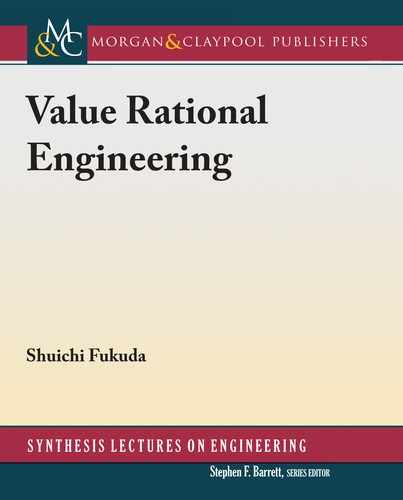
8.4. REPAIR: ANOTHER NEW VALUE CREATION 41
Long-term expectations fall outside of the bounds of rationality. While Simon told us
satisficing is the only solution outside of the bounds, he did not show any quantitative solu-
tion [2]; Keynes, however, told us we can manage to do long-term quantitative expectation, if
we feel confident.
Simon is more interested in decision making and Keynes’ work is in the area of economic
expectations. So, their goals are different, but it is interesting to know how confidence or trust
can extend our quantitative evaluation outside of the bounds of rationality.
8.4 REPAIR: ANOTHER NEW VALUE CREATION
We have discussed how continuous prototyping software development contributes to trust build-
ing. Now, let us look at it from another angle.
If we turn the software development figure (Fig. 8.3) upside down and compare it with the
hardware one (Fig. 8.2), we realize both are identical (Fig. 8.6). en, aren’t there any ways we can
apply to control degradation of hardware? When hardware engineers talk about deterioration,
they say they must prevent failures. But deterioration and failures are different. Of course, after
deterioration failure occurs. But that is the last and final stage. Until then, deterioration goes
on gradually. And if we look at deterioration from another angle, it is the process nothing other
than fitting. All products come to fit us after using sometime. en, we feel the product is MY
product. It fits me perfectly. But most hardware engineers do not regard deterioration as the
process of fitting. ey just regard it as a step to failure. So, they believe if they can prevent
failure, that is the best way to guarantee product quality. eir mindset is still stuck with mass
products. But just as software is doing, if we can introduce a closed-loop control to deterioration,
we could possibly reduce time to fitting and keep fitting time longer. en, we can secure lifetime
customers.
Function
Software (Continuous Prototyping)
Validation
Customizing
Function
ShippingUse
Design
Function
Degradation
Restore
Shipping
Verification
Hardware
(Delivery of Finished Product)
Production
Maintenance
in Use
Figure 8.6: Looking at software development upside down.

42 8. RELIABILITY TO TRUST
Figure 8.7 shows a worn-out shoe. People or hardware people would throw this away. But
ASICS, a Japanese shoemaker, has a very different view. ey thought this deformation is due
to the way the customers wear. If the shoes deform this way, and they produce shoes that deform
this way, then they could fit the customer in much shorter time and in more comfortable way.
Figure 8.7: Wornout shoe.
So, ASICS developed shoes with the easy-to-deform middle part and the hard form-
keeping part (Fig. 8.8). Although you cannot recognize any difference from the outside, people
who wore this pair of shoes said “I do not feel I am putting on shoes. I feel like walking on my
own feet.” So, they enjoyed long walks and this product has been very successful.
Figure 8.8: Shoes for a long walk.
And, as ASICS also produces sports shoes, they applied the same idea there. Athletes do
not have time to adjust, but these shoes fit their starting form immediately. So, the same idea
worked very well for people to enjoy daily life as well as for sport athletes (Fig. 8.9).

8.4. REPAIR: ANOTHER NEW VALUE CREATION 43
Figure 8.9: Shoes for sport.
Hardware engineering should study how they can control deterioration and provide their
customers with the life-long joy of best fitting (best fit to personal use). is will certainly turn
their users to lifetime customers. And, it should also be added that such control of deterioration
is another activity of new process value creation.
..................Content has been hidden....................
You can't read the all page of ebook, please click here login for view all page.
